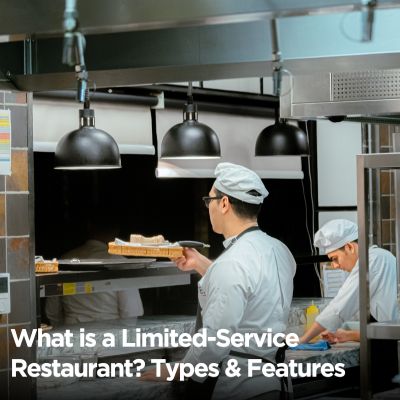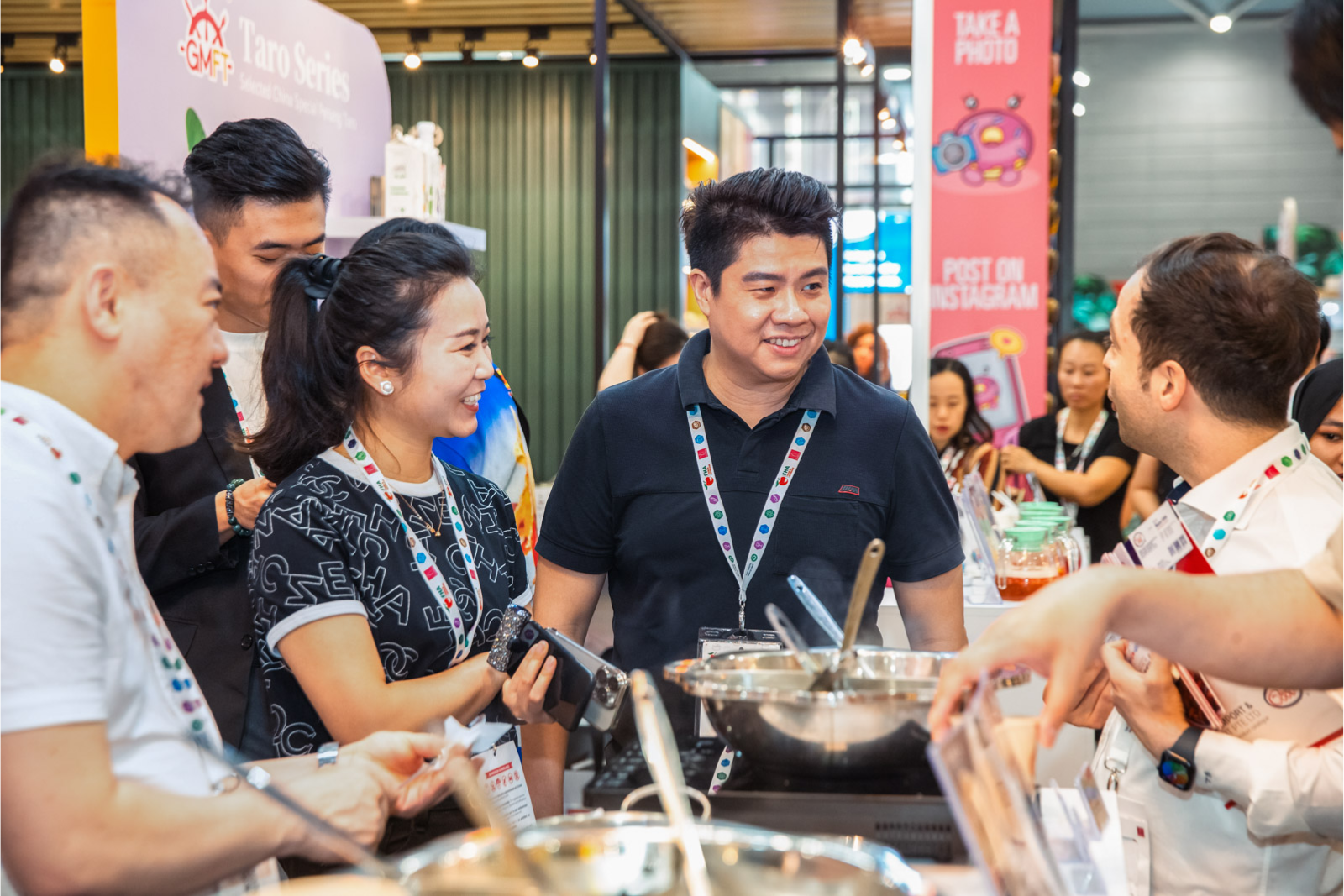Limited-service restaurants (LSRs) offer a streamlined dining experience. Customers place and pay for their orders before receiving their food, eliminating the need for traditional table service.
These restaurants are designed for speed, offering everything from fast food to more upscale fast-casual options. They cater to customers looking for a quick, affordable meal, focusing on convenience and minimal wait times.
Since the pandemic, LSRs have seen a significant rise in popularity. The Global Limited-Service Restaurant Market is projected to reach $1.6 billion between 2022 and 2028, growing at a 5.0% annual rate.
This growth shows how consumers now prefer quick and convenient dining options. LSRs offer a more relaxed and informal alternative to traditional restaurants, making them a favorite for those who prioritize convenience without sacrificing quality.
What is a Limited-Service Restaurant (LSR)?

A Limited-Service Restaurant (LSR) is a dining establishment where customers usually place their orders at a counter or kiosk, pay before eating, and often receive minimal or no table service.
This LSR restaurant model focuses on speed, convenience, and affordability, catering to customers looking for quick meals without the wait associated with full-service restaurants.
Its main characteristics include streamlined menus for faster preparation, high customer turnover, and efficient operations that minimize wait times.
Fast food chains dominate this sector, accounting for 75% of limited-service restaurant traffic, showcasing the widespread popularity of this dining format.
LSRs emphasize operational efficiency, allowing these restaurants to serve many customers quickly while keeping costs low. Many LSRs also incorporate self-service kiosks or mobile ordering to speed up the process further.
Unlike full-service restaurants, where diners wait and pay after meals, LSRs prioritize a grab-and-go or casual dining experience with minimal staff interaction.
This model appeals to busy professionals, students, and families seeking affordable and convenient meal options without sacrificing consistency or taste.
Key Characteristics of LSRs
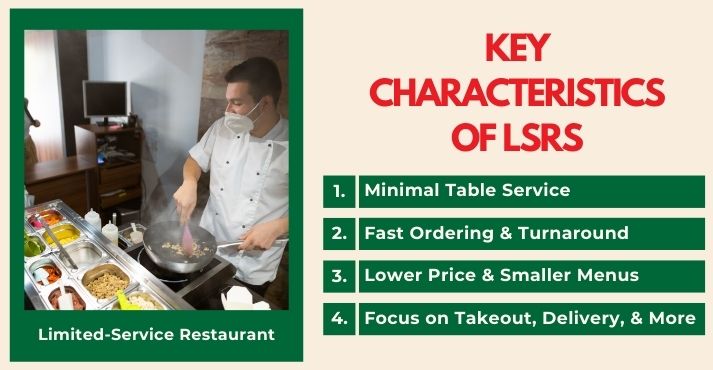
Limited-service restaurants (LSRs) are built around speed, convenience, and customer autonomy. Whether a quick-service restaurant (QSR) or a fast-casual spot, these models thrive by streamlining service and using technology to meet modern dining expectations.
1. Minimal Table Service
One defining trait of LSRs is the absence or significant reduction of traditional table service. Instead of servers taking orders and managing the dining experience, staff typically handle food delivery to tables or focus on clearing them post-meal.
Customers are expected to place their own orders, find their seats, and often clean up after themselves. This minimal interaction reduces labor costs and allows staff to focus on speed and cleanliness.
It also aligns with customer expectations in a quick-service restaurant (QSR), where efficiency outweighs personalized service.
A notable example of this model is Chooks-to-Go in the Philippines. Established in 2008, Chooks-to-Go operates over 1,800 take-out stores nationwide, offering roast chicken and processed meat products.
The brand emphasizes a take-out-only format, requiring customers to place orders at the counter and collect food without any table service.
2. Fast Ordering and Turnaround
LSRs focus on being fast. Orders are placed quickly at a counter, self-service kiosk, or via digital apps, making long waits a rarity. Restaurant technology helps by integrating systems that ensure kitchen staff can fulfill orders efficiently and customers receive their meals promptly.
In fact, a study by Harvard Business Review found that using self-ordering kiosks resulted in a 20% increase in revenue compared to traditional human cashiers.
The streamlined process supports high volume and fast table turnover — important elements in managing restaurant operations effectively.
Many LSRs also use automated kitchen display systems and mobile POS tools to increase accuracy and reduce bottlenecks, which helps maintain consistency even during peak hours.
A great example is McDonald’s, which has incorporated self-ordering kiosks in many of its locations worldwide. These kiosks reduce wait times and enable customers to customize their orders quickly while improving operational efficiency.
3. Lower Price Points and Smaller Menus
LSRs focus on being affordable and simple. These restaurants usually operate with smaller, focused menus, allowing quick preparation and consistent quality.
The menu usually includes straightforward, easy-to-prepare meals that appeal to various preferences, such as burgers, tacos, wraps, and salads.
This lowers operator costs and enhances customer satisfaction by minimizing decision fatigue in fast casual restaurant environments.
A smaller menu also enables tighter inventory control, faster training for staff, and more predictable demand, all of which contribute to smoother operations and better margins.
4. Focus on Takeout, Delivery, and On-the-Go Dining
Today’s LSRs are optimized for off-premise dining. Many prioritize takeout, drive-thru, and third-party delivery options over traditional dine-in setups. Packaging is customized for transport, and mobile ordering ensures a seamless experience.
As customer habits move toward convenience, LSRs use technology that supports delivery and enhances the on-the-go dining experience.
Drive-thru lanes, curbside pickup spots, and dedicated mobile order shelves are now standard. These features boost revenue and support customer expectations for fast, flexible service, making LSRs highly competitive in a digital-first market.
Types of Limited-Service Restaurants
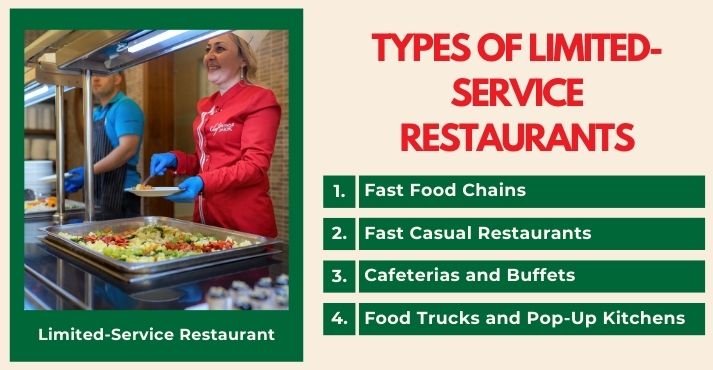
Limited-service restaurants (LSRs) come in different forms, but they all focus on speed and affordability. They run with efficient operations, minimal staff interaction, and simple service models to meet different customer needs. Let’s look at the main types of LSRs:
1. Fast Food Chains
Traditional quick-service giants like McDonald’s, Taco Bell, and Burger King are well-known examples of fast-food chains. These restaurants offer standardized menus with low-cost food designed for mass appeal and fast preparation.
The focus is on efficiency and consistency, allowing customers to receive their meals quickly without frills or customization options.
Unsurprisingly, around 83% of people in the United States eat at quick-service or fast-food restaurants at least once a week, showing how common and convenient this way of eating is.
Thanks to their massive scale, these chains can keep prices low and maintain a strong presence in nearly every city and town.
2. Fast Casual Restaurants
Fast casual restaurants sit between fast food and full-service dining, offering slightly higher-quality food and a better ambiance. While they still operate on a limited-service model, the food is often fresher and more customizable, focusing on healthier or gourmet options.
Popular examples include Chipotle and Panera Bread, where customers order at a counter but can expect more variety and a higher dining experience than typical fast food outlets.
3. Cafeterias and Buffets
Some cafeterias and buffet-style venues qualify as LSRs when payment is made upfront, and service is minimal. Customers generally serve themselves or choose from pre-prepared options.
These venues often emphasize convenience and speed, with minimal interaction with staff. The self-service setup helps these places serve more people quickly and keep prices low.
4. Food Trucks and Pop-Up Kitchens
Food trucks and pop-up kitchens offer a mobile version of the LSR concept. With no table service, these venues focus on fast, takeaway-friendly meals often prepared quickly and on-site.
They usually set up in busy spots like street corners or events and are known for serving fun, creative food at low prices. This setup offers convenience and suits customers who want a quick meal on the go.
How LSRs Differ from Full-Service Restaurants (FSRs)
Limited-service restaurants (LSRs) and full-service restaurants (FSRs) have different setups to match different dining needs. LSRs focus on speed, low prices, and convenience, while FSRs offer a slower, more personal experience with full table service.
Here’s a table that shows the main differences between them:
[fusion_table fusion_table_type=”1″ fusion_table_rows=”” fusion_table_columns=”” margin_top=”” margin_right=”” margin_bottom=”” margin_left=”” hide_on_mobile=”small-visibility,medium-visibility,large-visibility” class=”” id=”” animation_type=”” animation_direction=”left” animation_speed=”0.3″ animation_offset=””]
| Features | Limited-Service Restaurants (LSRs) | Full-Service Restaurants (FSRs) |
|---|---|---|
| Service Style | Self-service, counter ordering, or kiosk-based | Waitstaff take orders and serve food |
| Pricing | Lower price points, quick meals | Higher price points, often with multi-course meals |
| Customer Interaction | Minimal interaction with staff | High interaction with waitstaff and hosts |
| Table Turnover | High turnover due to fast meal prep and service | Lower turnover, longer dining experience |
| Ambiance | Casual, functional, focused on efficiency | Relaxed, cozy, and designed for longer stays |
| Tipping Culture | No tipping, payment is made upfront | Tipping is customary, often 15-20% of the bill |
[/fusion_table]
In full-service restaurants, waitstaff handles most of the service—taking orders, bringing refills, and helping throughout the meal. Customers usually spend more time at the table. In LSRs, people order for themselves and often clean up after eating.
This self-service setup keeps costs down and speeds up table turnover, making LSRs great for quick, on-the-go meals.
Advantages of Limited-Service Restaurants
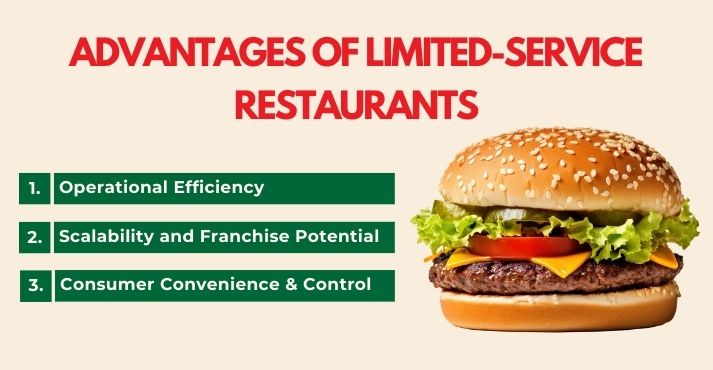
Limited-service restaurants (LSRs) have gained popularity thanks to their flexible, cost-effective models that meet business and customer needs.
With faster service, simple operations, and rising demand for convenience, LSRs are changing how people eat. Here are some advantages that make them stand out:
1. Operational Efficiency
LSRs run on streamlined systems that reduce complexity. Smaller menus, fewer staff, and faster service allow these businesses to operate with lower overhead.
This counter-service restaurant model cuts labor costs and speeds up service, making it easier to manage high-volume traffic during peak times.
Investments in restaurant industry technology like self-service kiosks, digital ordering apps, and kitchen display systems further improve accuracy and speed, helping owners keep operations tight and efficient.
2. Scalability and Franchise Potential
One of the biggest strengths of the limited-service food concept is its ability to scale. With standardized menus, simplified kitchen layouts, and repeatable service models, LSRs are great for franchising.
They require less space, fewer employees, and smaller upfront investments than full-service setups. This makes them a popular choice for entrepreneurs using restaurant marketing strategies to grow their businesses quickly.
It’s common to see LSR concepts showcased at a food and service equipment trade show, where scalability and innovation are major selling points.
3. Consumer Convenience and Control
Modern diners want speed, simplicity, and customization. LSRs offer just that — quick meals without long waits or unnecessary steps. Customers have more control over ordering through mobile apps, self-service kiosks, or at the counter.
This level of convenience appeals to busy individuals looking for a fast bite or takeaway. As a result, counter-service restaurants remain popular, especially with younger, tech-savvy customers who prefer fast, personalized meals over traditional dining.
Challenges Faced by LSRs
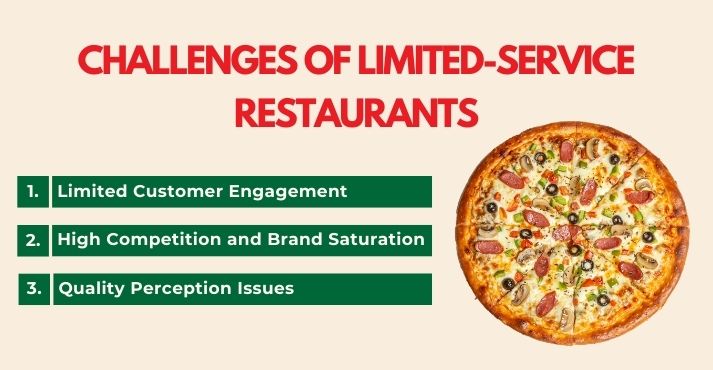
Limited-service restaurants offer speed and convenience but face challenges in a competitive, fast-changing market. With limited customer interaction and brand perception issues, LSRs must work to stay relevant and build customer loyalty.
1. Limited Customer Engagement
With minimal staff interaction, LSRs often miss opportunities to build strong customer relationships. The lack of personalized service means customers may not feel as connected to the brand, affecting loyalty.
Additionally, there are fewer chances for upselling, cross-selling, or engaging customers in ways that enhance their dining experience, as seen in full-service restaurants.
2. High Competition and Brand Saturation
The fast food and fast casual space is packed with competitors, making it challenging for new or smaller brands to gain visibility. Major players like McDonald’s, Taco Bell, and Chipotle dominate the market, leaving little room for smaller chains to differentiate themselves.
As new brands flood the market, standing out requires a combination of innovation in menu offerings, brand messaging, and customer experience.
3. Quality Perception Issues
LSRs are sometimes viewed as offering lower-quality or overly standardized meals. The focus on speed and cost-efficiency may lead customers to assume the food lacks freshness, nutrition, or creativity.
This perception can be hard to shake, especially when compared to full-service or specialty dining options.
Future Trends in Limited-Service Restaurants

The future of limited-service restaurants is shifting, with growing demand for convenience, healthier options, and sustainability. As technology and customer expectations change, LSRs adjust to new trends to stay competitive and meet these needs.
1. Automation and Self-Service Kiosks
Automation is becoming more common in LSRs, with kiosks, AI ordering systems, and mobile apps helping to speed up operations and reduce labor costs.
These technologies allow customers to place orders independently, reducing wait times and creating a smoother, more efficient dining experience.
By reducing the need for cashiers and servers, LSRs can improve order accuracy and create a more personalized experience with customized options. This trend will likely grow as technology improves, changing how quick-service restaurants operate.
2. Healthier Menu Innovations
In response to growing health-consciousness among consumers, LSRs increasingly offer healthier menu options, including locally sourced ingredients, plant-based meals, and lower-calorie alternatives.
Many restaurants are incorporating more balanced meals, including salads, grain bowls, and vegan options, to cater to the rising demand for nutritious dining.
Offering healthier options helps LSRs appeal to a wider range of customers, especially those more health-conscious and looking for better food choices.
3. Sustainability and Smart Packaging
More limited-service restaurants are focusing on eco-friendly practices as customer interest in sustainability grows. Many are switching to smart packaging like biodegradable, recyclable, or compostable materials to reduce waste from takeout and delivery.
Others are launching food waste reduction programs, including donating unsold meals, tracking inventory more efficiently, or shrinking portions to avoid excess. Some LSRs also use local ingredients to cut down on environmental impact.
These efforts help the environment and strengthen a brand’s reputation with customers who value responsible business practices.
Conclusion
Limited-service restaurants (LSRs) have become a major part of dining by prioritizing speed, convenience, and affordability.
While they face challenges such as high competition and limited customer engagement, LSRs adapt by integrating technology, offering healthier menu options, and focusing on sustainability.
As customer preferences change, LSRs will continue to find new ways to stay relevant and meet the needs of modern diners through innovation and efficient service.

